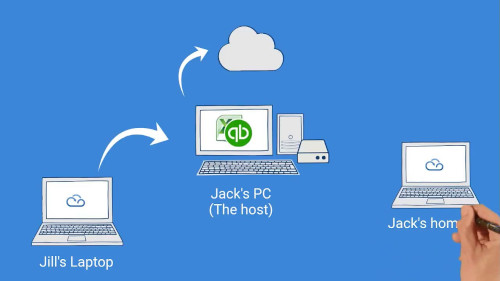Remote working is slated to be the future of our global workforce. You might be more familiar with its old name: “Telecommuting”. Whatever you call it, the flexibility to work outside an office is the logical next step in a world with smartphones and wi-fi.
But more than just the name has changed in the last decade, and it’s expected to keep evolving. As 2020 approaches, a lot of progress is expected in the coming year. Before we get into the predictions for the future of remote working, let’s talk about the present.
- The Transition to a Digital Workplace
- How Does Remote Working Impact Employees
- The Pros and Cons for Businesses
- Remote Working Trends in 2020
The Transition to a Digital Workplace
2019 has been a big year in remote working, with about 66% of companies in the US employing remote workers. Working outside the office is no longer just for the self-employed or contract employees.
Around the world, 70% of professionals in traditional office jobs work remotely at least once a week. Technology is advancing and, with that, there’s a trend towards an increasingly mobile business model. Both employees and employers benefit from remote working.
How Does Remote Working Impact Employees?
One major catalyst for the move to remote work is employee satisfaction. The demand for job flexibility is paramount among many workers.
Millennial’s especially seem to be driving this trend, due to households in which both parents are working, the high costs of rent to work in big cities, the stress/time of commute if you live outside of the city, and the aim of having varied life experiences are more pronounced.
Remote working can offer a much better work-life balance for these professionals.
Of course, it does have its drawbacks. When your work doesn’t stop at the office, it can be difficult to maintain that balance, especially when some companies rely on remote workers to be available at different hours. And a common complaint that some remote employees report is loneliness, because of that lack of interpersonal interaction throughout the day with co-workers.
Additionally, two activities that happen organically in an on-premise environment are also lacking when you work off-site: staying motivated and keeping up-to-date with management. When you’re in an office, the change of environment can boost productivity, and you’re continuously communicating with your team and management from the office.
But many of these pitfalls can be avoided, and the benefits of remote working often outweigh the downfalls. It’s important to maintain a line of communication with management and coworkers, develop strong self-discipline and work habits to keep yourself motivated, and find a method of separating your work hours from your life to maintain balance.
If it’s any indication, a stark majority of freelancers would recommend a remote career to a friend.
The Pros and Cons for Businesses
The benefits don’t stop with employees – companies have a lot to gain from moving their businesses in this direction. When a company goes remote, that opens up the talent pool exponentially. There is untapped potential outside of your city of operation: small towns, other big cities in your state, other states, and other countries. The productivity of your business doesn’t stop in your timezone or in your hours of operation.
The growth with a team of top tier professionals in multiple time zones is staggering. However, a primary obstacle when transitioning to a digital workplace is the potential breakdown of communication. A traditional office environment makes it simple to keep everyone on the same page. Fortunately there are many tools and services that help keep teams on track.
Not only can you hold video meetings and conferences online, but also collaborating on projects from anywhere is now commonplace. Slack, Trello, Google Hangouts, and Skype are among these options. Perhaps more important than the technology to use is to modify the structure of your projects and business.
Fostering the development of a forward-thinking work environment will ensure remote working continues to reap many rewards. Two important things to consider are project management and training. “Agile methodologies” were originally devised to facilitate software development by tech companies. Even though the core tenets were created for this purpose, there are many principles that you can apply to coordinate projects more effectively.
Maintaining a regular line of communication, trusting team members, breaking up projects into actionable parts, and continuously re-evaluating progress with the consumer in mind are important to almost any venture. These concepts are especially important when managing teams that are located in multiple states and countries.
Since 2018, 6x of hiring managers report that they believe agile teams will increase. Online training programs are also important to improve the remote workforce: 67% of remote employees report the need for more training, with nearly half that figure either paying for it out-of-pocket or receiving none altogether.
Investing into training programs is useful in any business, but perhaps especially for remote teams.
Remote Working Trends in 2020
In 2019, 16% of workplaces were fully remote, and that figure is expected to rise. Upwork, a popular freelancing platform, did a study that highlights business attitudes and predictions. Hiring managers believe that remote work will be changing up the workplace even more than automation and artificial intelligence.
One key development that is shaping the business world is the move to cloud computing – using services to keep your applications and files in data centers. You don’t need to have a physical office in order to run your business anymore.
Between all of the different types of cloud offerings, over 60% of all enterprise businesses are using it. And this is expected to continue growing, as more services are created to meet the needs of our global digital market. The type of cloud you’re most familiar with is known as “Software as a Service”, or “SaaS”.
You use this powerful technology every time you store files in Google Drive or Dropbox. Businesses use MailChimp to send promotional emails, and they use SalesForce to manage purchases and sales cycles. As the adoption of cloud technologies increases, their price tags trend downward.
By 2020, it’s projected that 75% of professionals will be working remotely in some capacity. Many companies are even adding work travel into their benefits packages so you no longer have to choose between a vacation and a job. Cafes, hotels, airports, and restaurants are setting up wi-fi and spaces for these “digital nomads” to take their profession on the road and across the world.
The demand for remote work is growing, for companies as well as for employees, pushing for an increasing shift towards digital workplaces.
Sources:
https://www.inc.com/scott-mautz/the-future-of-remote-work-is-happening-now-heres-how-to-make-it-work-for-you.html
https://www.glassdoor.com/employers/blog/future-of-work-remote/
https://remoteyear.com/blog/remote-work-future
https://www.businessnewsdaily.com/8156-future-of-remote-work.html
https://www.atlassian.com/agile/teams/remote-teams
IaaS vs PaaS vs SaaS: What You Need to Know + Examples (2018)





